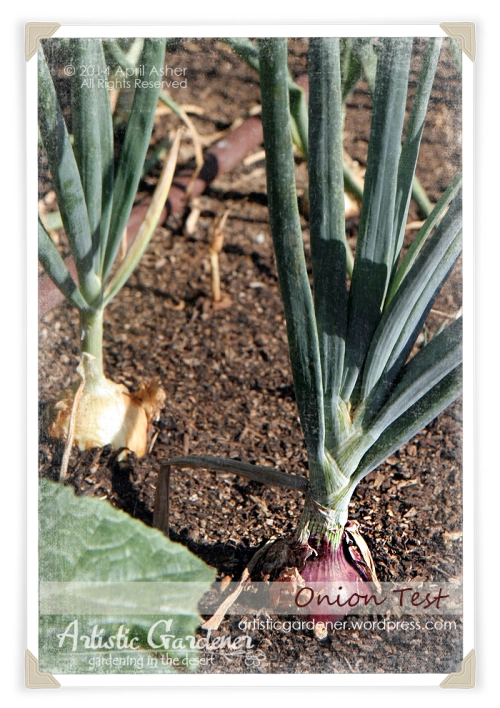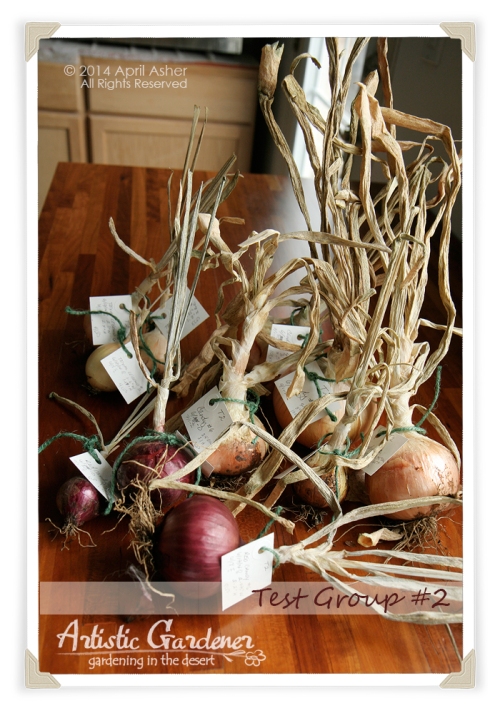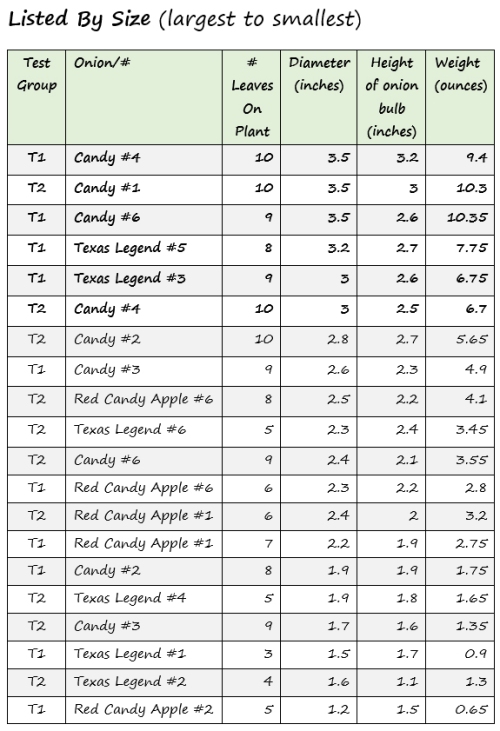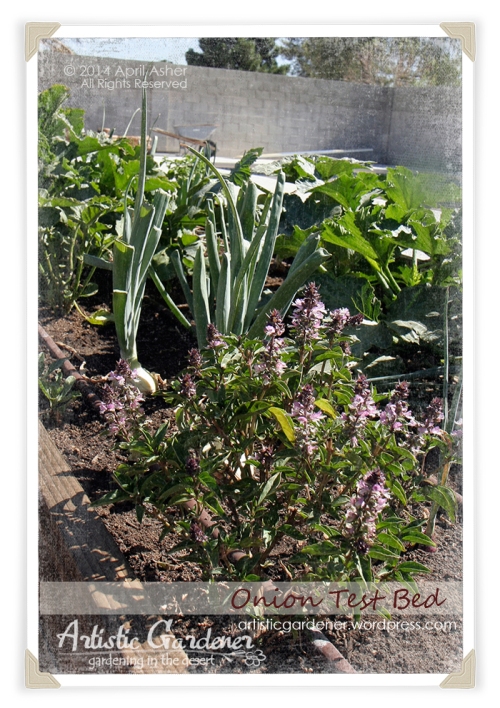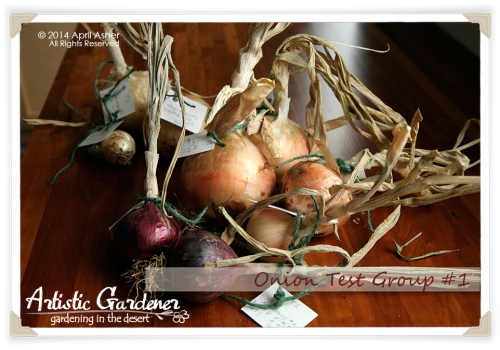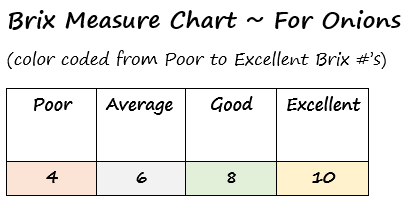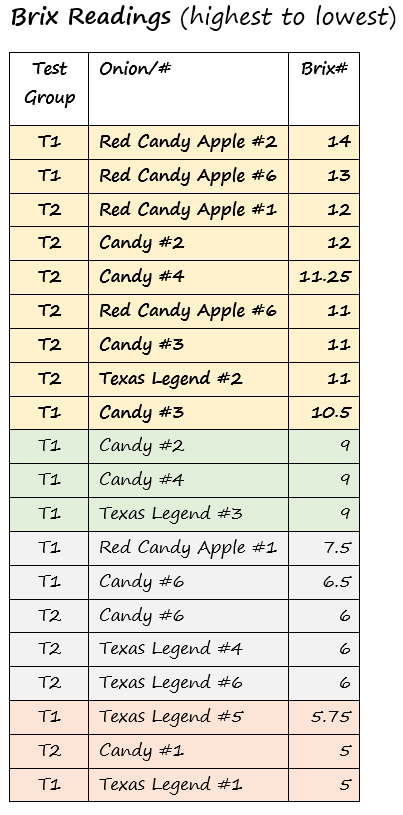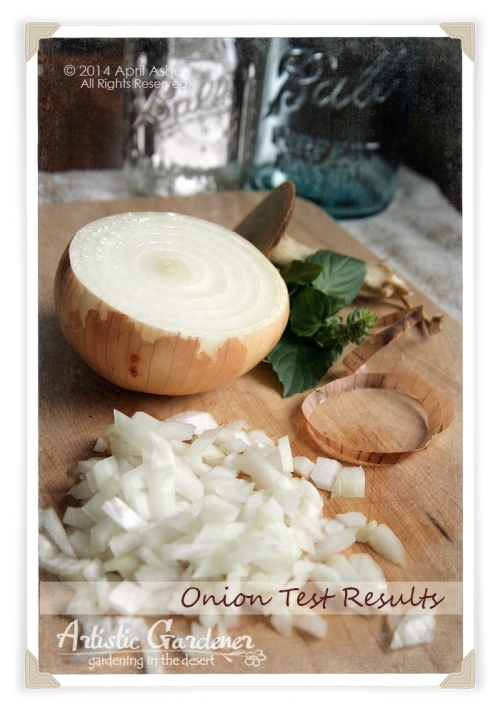The bulbing onion test results are finally in. For those of you who have been waiting patiently for the results and would like to review my test information from the beginning or if you’re unfamiliar with the test I performed and would like to learn more, you can check out the details in my original post here.
Here’s a quick recap… in March of this year, I was asked by a horticulturalist friend of mine to evaluate a product called Kelzyme in my garden. The Kelzyme product is a ‘rock dust’ type of product that is derived from a seabed deposit of fossilized marine kelp. The manufacturer claims that the product is a rich source of highly absorbable organic calcium and also contains about 70 trace minerals, both highly attractive ingredients for us nutrient focused gardeners (a.k.a. high brix/nutrient dense). This product comes in a micronized version, but the Kelzyme product I was given to test was fairly granulated and “rocky”. For rock dust products, I typically prefer to use a micronized version. The finer particle size is easier for the soil microbes to break down making the minerals available to the plants sooner. Coarser materials take much longer to break down and tend to sit in the soil as the soil microbes “work it” releasing only small amounts of its coveted mineral treasures over a longer period of time.
FYI high brix/nutrient dense gardeners ~ next year I plan to experiment with a couple of beneficial soil bacteria that are new to me and my garden and will be a fairly inexpensive addition to my gardening regimen. One bacteria targets the break down of rock dusts and the other is anaerobic and helps plants to live and thrive in salty soil environments (like our soils in the desert). Bottom-line… more available nutrition for my plants. I’m anxious to get started in the spring and will keep you updated on my progress.
For now, just keep in mind that not all soil microbes and bacteria are created equal. Some live better in certain environments (i.e., fresh water, brackish water, clay soils, sandy soils, etc.) while some bacteria are better at certain tasks than others (i.e., breaking leaf litter vs. rock dusts). There’s big science involved in world of soil biology that I certainly do not claim to know… like at all, but I find this topic fascinating and read up a lot on the research and findings being done by scientists and technical experts who have dedicated their lives to this subject.
Since I had just received a fresh batch of bulbing onion transplants and had recently prepared my 4×10 raised bed for planting, I decided the onions and planting site was the perfect choice for testing the Kelzyme product.
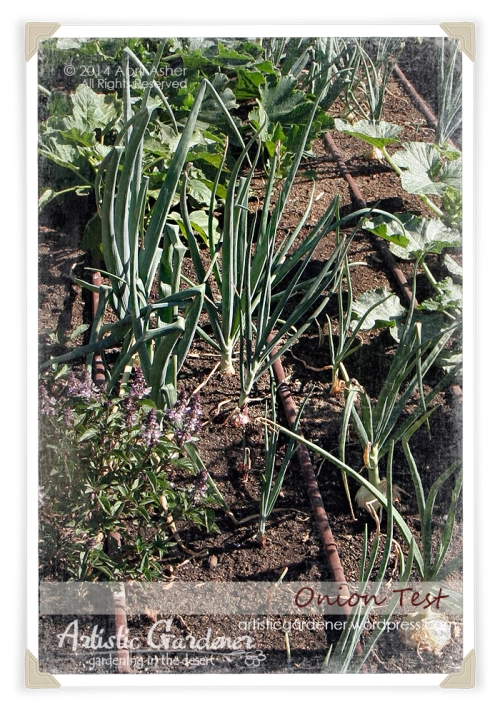 The onion transplants were purchased from Dixondale Farms, and consisted of the following varieties:
The onion transplants were purchased from Dixondale Farms, and consisted of the following varieties:
- Candy (intermediate day)
- Red Candy Apple (intermediate day)
- Texas Legend (short day)
I broke the onions into two distinct groups… Test Group #1, I used the Kelzyme product. Test Group #2, I added the John & Bob’s suite of products. The onions were divided up evenly among the two groups with each group receiving the following: six Candy onions, six Red Candy Apple onions, and six Texas Legend onions.
In order to do a fair assessment of the Kelzyme product, I considered several factors throughout my test including…
- Number of leaves each plant generated
- Onion bulb size (diameter and height)
- Onion bulb weight
- and finally, the Brix reading for each onion
As the onion plants were growing, I referred to a hard copy chart I made to keep track of who was who. For after harvest, I made up several little tags that I used to tie onto each onion as I harvested them in order to properly identify each individual within the two different groups.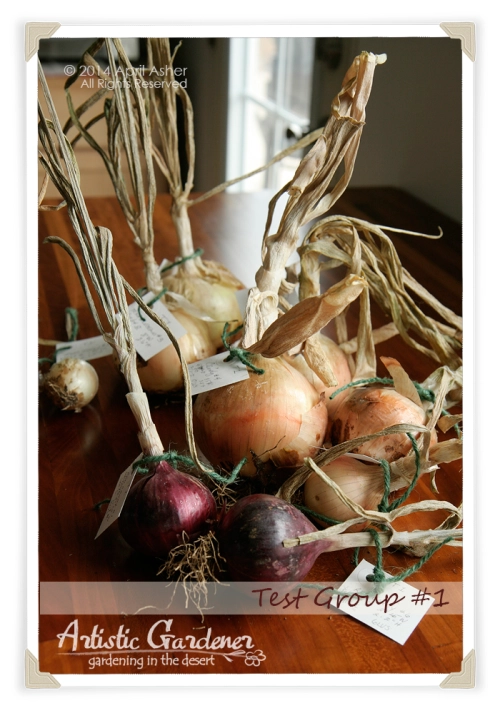
Once harvested, I left the onions in the raised bed for about three days under the protection of my squash plant leaves to help prevent sunburn on the newly exposed onion bulbs. I then carefully collected the onions and moved them indoors where I hung them for a couple of weeks in a warm room to begin the curing process. Eventually, I moved the onions to another room where I laid them out flat to finish the curing process, which took an additional 4 weeks (6 weeks total). When completely cured, I cut-off the dried leaves leaving about 1-inch of stem on the onion bulb then moved them all to a cool dark place for storage. With the curing process complete, I started the Brix portion of my onion test. To perform this portion of the test, I had to cut open each and every onion to test the brix using my refractometer. Rather than do this all at once and have to freeze all my onions, I opted to use 1-3 onions in my normal cooking routine each week and test the brix immediately after cutting an onion open. During this phase of my test, I did not see any significant difference in the readings for onions I cut open earlier versus later in the process.
With the curing process complete, I started the Brix portion of my onion test. To perform this portion of the test, I had to cut open each and every onion to test the brix using my refractometer. Rather than do this all at once and have to freeze all my onions, I opted to use 1-3 onions in my normal cooking routine each week and test the brix immediately after cutting an onion open. During this phase of my test, I did not see any significant difference in the readings for onions I cut open earlier versus later in the process.
Test Results and Observations
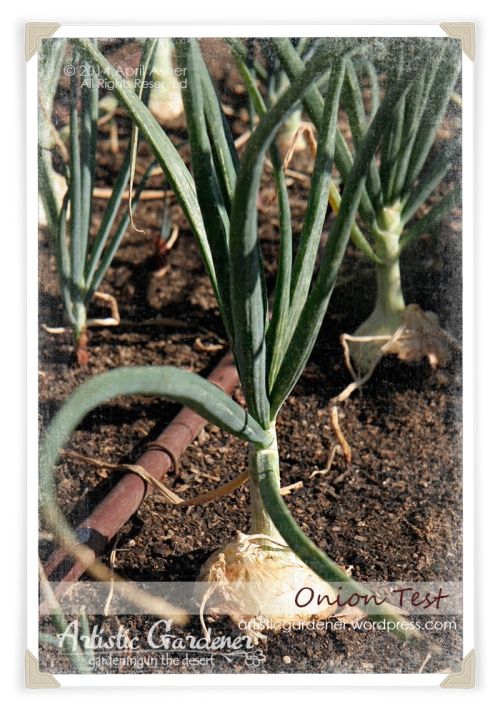 Now, let me share with you some of the stats and my observations…
Now, let me share with you some of the stats and my observations…
Out of the 36 original onion transplants (12 of each variety), only 20 onions matured to full size. The other 16 onions failed to grow beyond the original transplant size. Both groups had an equal number of onions that failed to grow (as you can see from the chart below). Though the fact that less than 1/2 of my onions failed to grow was disappointing in and of itself, I feel that the cause of this is not a result of either of the products used, but rather some other consideration entirely. I won’t even try to speculate at the cause.
Size & Weight
Nothing really stands out to me in this category. By looking at the chart below, you’ll see that the Kelzyme group (T1) had the largest sized onion coming in at 3.5”diameter x 3.2” height, but the John & Bob’s group (T2) was very close behind coming in at 3.5” diameter x 3.0” height. Size wise, neither group produced any onions of any size worth writing home about. This could have been a direct result of the high nitrogen OMRI organic fertilizers I used before the onions began to bulb-up. I flat-out refused to use the ammonium sulfate product the grower recommended which is horrible for soil health. Despite all this, neither of the test group products seemed to visibly boost the bulb size. I also wanted to point out that the soil I used in my raised bed (from ViraGrow) was new and already contained high levels of nitrogen (which I confirmed from a soil test I had performed just before planting). The high level of nitrogen seemed to have little effect on the onion size, either. The soil test also indicated extremely low soil microbial activity which probably played a significant role in the unimpressive onion sizes.
To determine each onion’s size, I measured both the diameter and height of each onion bulb using a dial caliper tool.
Though I did have a total of six (6) onions that were 3 inches to 3-1/2 inches in diameter, overall, I was far from impressed. Especially since I was hoping that the Candy and Texas Legend onions would get close their size potential of 6 inches. Not even close!
Regarding the number of leaves on each onion plant, my documented numbers are all over the place (see chart above), but I can say that the larger bulbs (3-inch and larger in diameter) did, on average, have more leaf growth than the smaller sized onion bulbs.
Size Conclusion~ Unimpressive ~ no real winner. In my opinion, the test results are too dismal to compare. For those of you with OCD, I guess the Kelzyme group (T1) can be pinned the size winner with its, ooh, wait for it… 3.5” x 3.2” sized Candy onion. Keep in mind that it only won by a hair as the John & Bob’s group (T2) was right on its heel with a 3.5″x3.0″ sized Candy onion.
Brix Reading
Well, after the uninspiring size and weight results for both test groups, I was just about ready to throw in the towel and call it a wash, when suddenly it donned on me, “hello, miss I’m all about growing high brix/nutrient dense food. Test the brix!”
So like any good high brix/nutrient dense grower would do, I pulled out my refractometer along with my handy-dandy OXO garlic press (which by the way, I love!) and began to cut open and test my first onion. Though the entire Brix testing process took some time, the results were worth the time and effort involved. Finally, results interesting enough to ponder over.
To help make some sense of these results, I provided a Brix Measure Chart ~ For Onions (below) so you could first see what the experts say an onion brix reading of poor, average, good and excellent look like. To help even further, I’ve color coded the chart and used this color coding in the chart that contains my test results below. For those of you interested in downloading a complete brix chart, you can find it here.
In the chart above, you can see that the Kelzyme group (T1) did have the two highest brix numbers coming in at 14 and 13. For me, I found this interesting and it makes me want to explore the Kelzyme product further, especially in combination with other products I use. What really caught my attention, though, was the fact that the John & Bob’s group (T2) had double the number of onions in the above Excellent range. This was even despite the fact that the raised bed soil originally started off with extremely low microbial activity. I also find it quite impressive that almost half of the onions planted were above an Excellent rating of 10. In hindsight, it would have been very helpful to have been able to compare the results with onions planted in soil that had no additional amendments added (a.k.a. a baseline group). Oh well, next time.
Though the results from my small-scale far from perfect test are nowhere near worthy of being published in any scientific research papers and such, I do feel that the brix results is an indicator of the positive impact the soil microbes and minerals I used (i.e., John & Bob’s product) had on my onion plants. Ultimately a big plus for the nutrition of the food I eat from my garden ~ regardless of size.
Brix Conclusion ~ I honestly have to say the beneficial bacteria, microbes and minerals are the winners in this category. Evidence that these little helpers have a positive impact on the nutrition levels of the plant.
Final Note
Even though my test was far from perfect and no extraordinary growth was observed, I do feel that the Kelzyme product deserves a second look. My test results definitely demonstrated promise in the area where microbes and minerals were concerned, especially in a soil that started off essentially void of microbial activity.
I’m also interested in testing the Kelzyme product with tomatoes and peppers since the manufacturer claims the product is high in absorbable calcium. More to come on that.
Hopefully you found my onion test of some value and that it at least peaked your interest in using beneficial bacteria, microbes and minerals in your garden to grow fruits and veggies that are high brix and nutrient dense. Until my next post, keep warm and keep growing!
God Bless,

